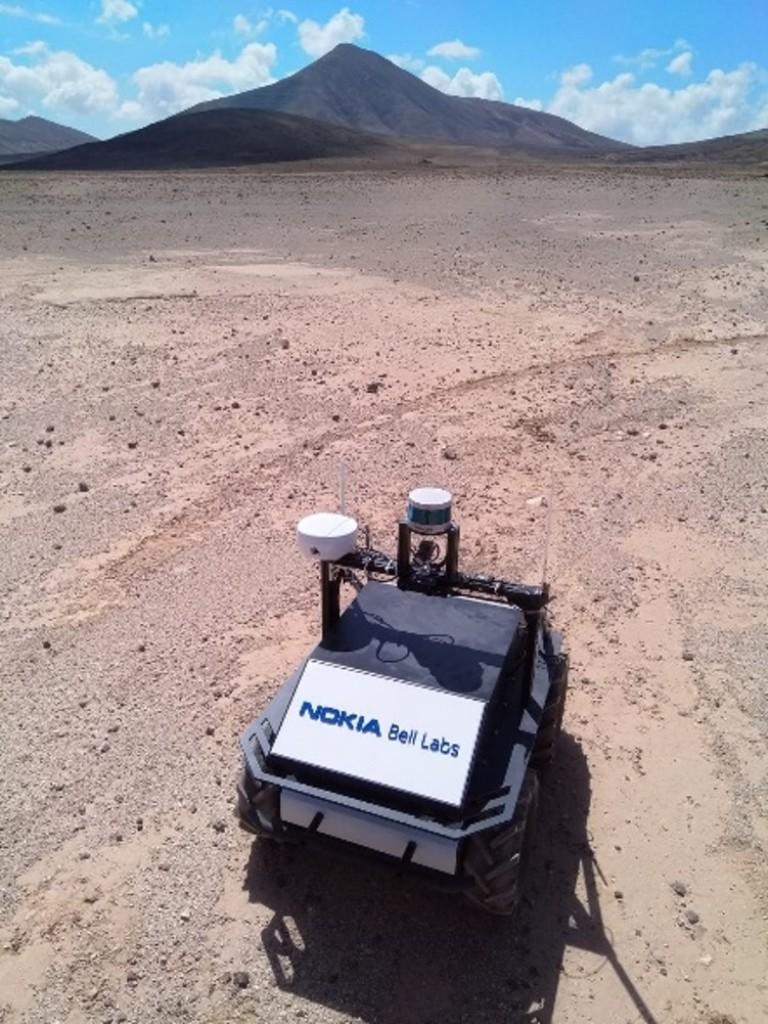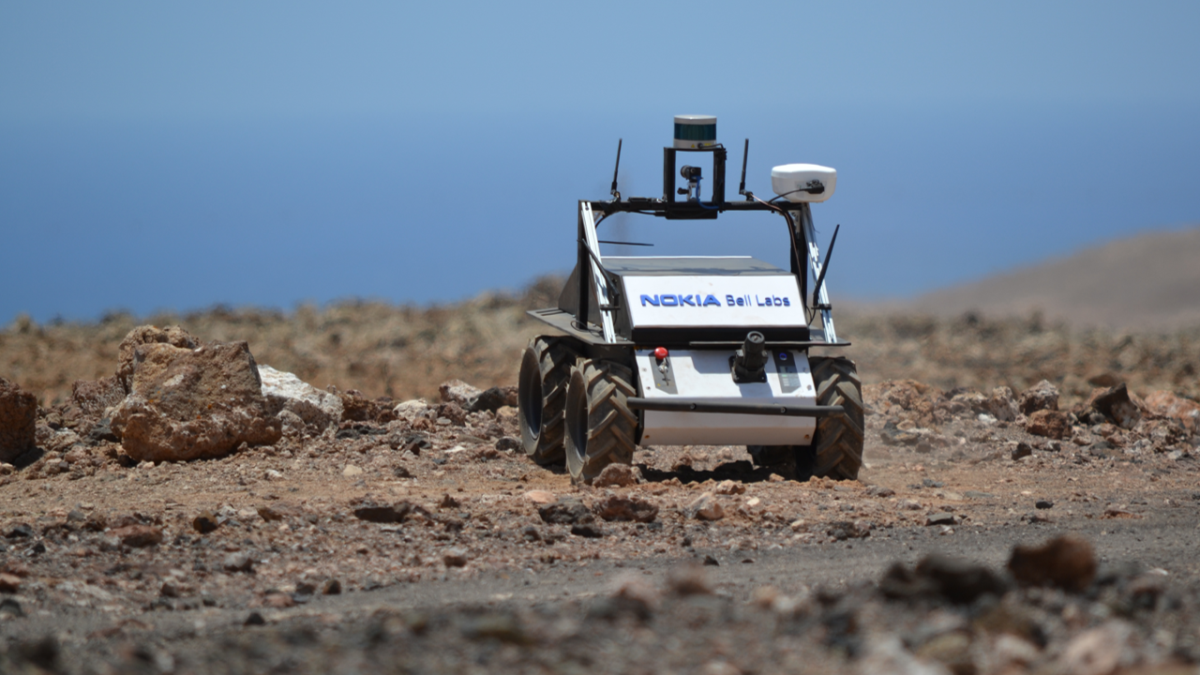
In addition to food, sleep or spacesuit design, equally as important to life in outer space is appropriate communication.
Image: Nokia Bell Labs and Intuitive MachinesFrom connecting offshore oil rigs and underground mines, to letting climbers livestream from 5,200 meters above sea level on Mount Everest: 4G networks are already capable of reaching some of the most remote spots on the planet. Now, the technology is gearing up for its next, extra-terrestrial challenge – to connect the Moon.
NASA is planning to establish a sustainable human presence on the Moon by the end of the decade as part of its Artemis program, and with such a project inevitably comes a host of logistics issues. But although food, sleep or spacesuit design might be first to spring to mind, equally as important to life in outer space is appropriate communication.
This is why, with 4G networks – and the LTE technology that supports them – having already proven their resilience back on Earth, last year NASA turned to leading telecoms provider Nokia with an unusual request: to design a system that will establish a 4G network to be used by future moonwalking astronauts.
The idea of internet-equipped space is not new. Astronauts on the International Space Station (ISS), for example, have been using Wi-Fi since 2008, and can now connect even their spacesuit to the network to stream video from space, communicate with other extraterrestrial vehicles or facilitate docking procedures.
SEE: Network security policy (TechRepublic Premium)
NASA has also developed proprietary software to enable communications between space and Earth, which requires an extensive network of antennas set up around the globe, as well as relay satellites, to forward data across billions of kilometers back to the ground.
Nokia’s option differs slightly, in that the company was tasked with setting up a local network on the Moon, which will only extend across roughly five kilometers, to enable communication between astronauts and equipment on the ground.
“In their personal lives, astronauts have smartphones – so when they go into space, why would they not have access to the same capabilities for their communication and collaboration needs?” Thierry Klein, head of the industrial automation research lab at Nokia Bell Labs, tells ZDNet.
With space-equivalents of smartphones and devices connecting to a local moon-based 4G/LTE network, says Klein, astronauts would benefit from higher throughput, lower latency, and a larger range than they would with Wi-Fi.
The network will take on various data-transmission applications, ranging from ordinary voice and video communications to remote control of lunar rovers, real-time navigation and streaming of high-definition video.
While for now NASA is mostly thinking of using lunar 4G for experiments such as remote driving a rover to more distant locations than would be possible with Wi-Fi, Klein does not shy of thinking big. “In the future, as we establish a longer-term presence on the moon and build more communities, and perhaps in the future on Mars, there will be more needs for voice communication,” he says.
In the near future, however, the focus remains on making the technology work reliably as part of a first, un-crewed mission planned for 2022, to test the readiness of the technology and validate some of the key applications before Nokia’s 4G infrastructure can be used by actual astronauts at a future date.
To transport 4G technology to the moon, Nokia is working with autonomous spacecraft company Intuitive Machines, which is building a lunar lander to carry the LTE communications system through space, and safely deliver the network equipment to the lunar surface.
Nokia is fitting Intuitive Machine’s lander with an LTE base station similar to those found in Earth-based 4G networks, which will self-configure upon deployment – but in this case, the station will be made into a compact single unit that integrates several network components, such as Evolved Packet Core (EPC) functionalities and RF antennas.

The lander will then deploy a rover that will drive off with user equipment.
Image: Nokia Bell LabsThe lander will then deploy a rover that will drive off with user equipment: “The equivalent of a smartphone, but hardened for space conditions,” says Klein – and an omni-directional antenna that will link back to the base station and effectively establish 4G connectivity.
A satellite connection will then be used from the lander to communicate with mission control back on Earth, from where commands will be sent, and network equipment will be remotely managed.
On the face of it, therefore, the process sounds straightforward and fairly similar to the deployment of a conventional network. That is only on the face of it, though: as Klein explains, the constraints of space mean that every detail has to be carefully planned for.
First, there is launch and landing. “The system has to be mechanically robust for launch and landing, to withstand shock, vibration, acceleration and all the mechanical stresses that come from just deploying it in space,” says Klein.
SEE: Wi-Fi hotspots, pollution meters, gunshot locators: How lampposts are making cities smarter
Even once the lander has successfully reached the lunar surface, he continues, the system must be ready for the extreme temperature variations of outer space, as well as terrain characteristics that are specific to the moon – ranging from different radio propagation to rock boulders, mountains and craters.
There is also the question of size, weight and power, all of which have to be reduced to a minimum when venturing into space. “You want reliability, and we have built redundancy in the system, but you have to balance this out with size, weight and power consumption,” says Klein. “A lot of work is going into integrating the system as much as possible to reduce all of those.”
It goes without saying that the system is undergoing all sorts of rigorous testing. In test chambers, the equipment has been subjected to a series of 25 experiments involving different accelerations and vibrations, but also temperatures, radiation levels and even an operational vacuum.
What’s more, with a number of eerie, moon-like landscapes on offer even on planet Earth, Nokia has taken the system out in the open to gauge how well the technology performs on solid ground.
For example, in the Canaries archipelago in Spain, the island of Fuerteventura has a volcanic landscape with a similar setup to the moon. Klein and his team traveled to the spot and deployed the equipment, checking how the antennas performed at different heights and configurations, in a setting devoid of trees or buildings.

Klein and his team traveled to the Fuerteventura island in Spain to deploy and test the equipment.
Image: Nokia Bell LabsBut even more than ensuring that the hardware survives, explains Klein, it is the possibility of software glitches that keeps him up at night. In effect, if the system fails for any reason, sending a technician out to have a look won’t exactly be an option.
“We do remote maintenance on Earth, of course, but you always have the possibility to send somebody out,” says Klein. “Once this network is launched, we have to be able to absolutely operate this remotely.”
SEE: Quantum sensors could soon be heading into space
To this effect, Klein is constantly tweaking and refining Nokia’s operation and maintenance software suite, to let the team reboot, make configuration changes and manage the lunar network remotely – albeit with the knowledge that some setbacks are bound to happen, without any way of preparing for them in advance.
“Ultimately, the only thing to do is fly and test it for real,” says Klein. The timing is aggressive: Klein and his team were given two years between the moment Nokia was selected and the first targeted launch. That’s not a whole lot of time to prepare to bring 4G/LTE to the moon; but for Klein, the project is on track to stick to the deadline. It looks like the next few years, therefore, will see even the Moon going through its very own digital transformation.























